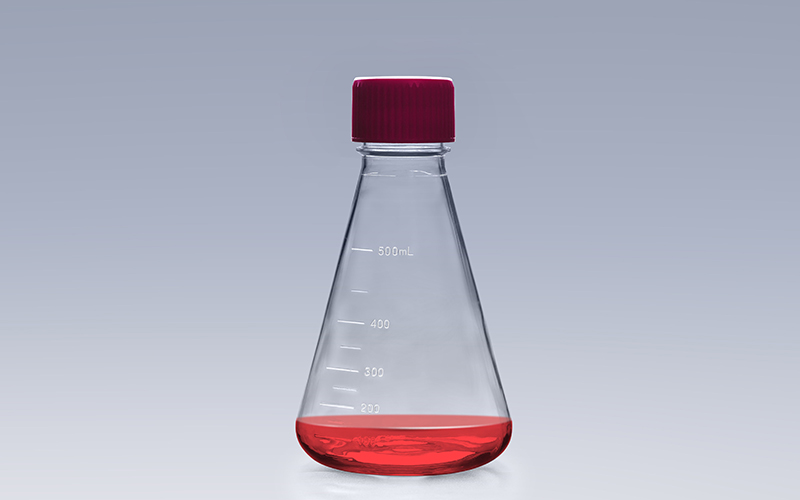Among the various methods for cell culture, the Erlenmeyer shake flask has become an ideal choice for the cultivation of suspension cells or bacteria, owing to its unique design and high-efficiency cultivation outcomes. It plays a crucial role in both laboratory and industrial-scale cell culture amplification. It not only enhances cell proliferation rates but also optimizes gas exchange and nutrient distribution, thereby improving cultivation efficiency. This article will explore the materials, specifications, and applications of the Erlenmeyer shake flask, providing practical references for cell culture in both laboratory and production environments.
Materials and Design of Erlenmeyer Shake Flasks
Erlenmeyer shake flasks are typically made from high-quality plastic materials like PETG (Polyethylene Terephthalate Glycol) or PC (Polycarbonate). These materials offer excellent transparency, thermal resistance, and biocompatibility, ensuring both clear observation of the culture and support for cell growth. They can also withstand the mechanical stress from shaking and agitation, ensuring stability in the cultivation environment.
The design of the Erlenmeyer shake flask is usually a conical flask shape, which helps to evenly distribute the culture medium and promotes gas exchange. During shaking, the conical shape effectively prevents liquid from remaining stagnant, aiding in the uniform distribution of cells in the medium, which in turn enhances cell proliferation rates.
Additionally, Erlenmeyer shake flasks are equipped with both breathable caps and sealed caps, which can be selected based on the needs of the cultivation environment. The breathable cap facilitates gas exchange, making it suitable for suspension cell cultures requiring oxygen; the sealed cap is ideal for closed cultivation systems or conditions requiring lower oxygen concentrations.

Common Specifications and Capacities
Erlenmeyer shake flasks come in various specifications to meet different scale cultivation needs. Common specifications include 125ml, 250ml, 500ml, and 1L, which cater to both small-scale experiments and large-scale production.
125ml Erlenmeyer Shake Flask: Suitable for small-scale experiments and cell amplification, ideal for early-stage cell culture or small-scale cell expansion experiments such as drug screening or cellular trait studies.
250ml Erlenmeyer Shake Flask: This specification is widely used in laboratories for medium-scale cell culture, commonly employed in biopharmaceuticals, vaccine production, and cell engineering for cell amplification.
500ml Erlenmeyer Shake Flask: With a larger capacity, this flask is suitable for large-scale cell culture, especially for cultivating high-density cell cultures at intermediate production scales.
1L Erlenmeyer Shake Flask: A 1L Erlenmeyer shake flask is commonly used for large-scale cell culture in biopharmaceutical production and antibody generation. It can accommodate a larger volume of culture medium and support cell growth in a larger space, often used in industrial-scale production or large-scale cell expansion.
Advantages of Erlenmeyer Shake Flasks
Improved Gas Exchange Efficiency: The design of the shake flask and the choice of materials allow the culture medium to be evenly agitated, increasing the contact area between the liquid and air, thereby providing ample oxygen for cell growth and efficiently removing carbon dioxide.
Enhanced Cell Growth: Shaking helps maintain uniform distribution of cells in the culture medium, preventing cell sedimentation or aggregation, which promotes healthy growth and efficient cell proliferation.
Space and Cost Efficiency: Due to their high-efficiency cell culture capability, Erlenmeyer shake flasks can perform large-scale cell culture in limited experimental spaces, reducing both laboratory and production costs.
Flexible Cap Options: The choice between breathable and sealed caps allows Erlenmeyer shake flasks to adapt to different cultivation environments. Oxygen and carbon dioxide concentrations can be adjusted according to the experiment's requirements, meeting the needs of various cell types.

Applications of Erlenmeyer Shake Flasks
Erlenmeyer shake flasks are widely used in suspension cell culture and bacterial cultivation, especially in the following fields:
Biopharmaceuticals: In the production of vaccines, antibodies, and recombinant proteins, Erlenmeyer shake flasks provide the right growth environment for suspension cells, supporting large-scale cell proliferation and production.
Cell Engineering: Used in cell amplification, gene editing, and viral vector production, Erlenmeyer shake flasks meet different cell culture needs across various research activities.
Cell Therapy: Erlenmeyer shake flasks are commonly used for cell amplification in cell therapies, such as stem cell therapy and CAR-T therapy, ensuring sufficient cell numbers for clinical treatments.
Microbial Fermentation and Culture: In addition to cell culture, Erlenmeyer shake flasks are also widely used in microbial cultivation, especially for bacteria, yeast, and other microorganisms in growth and metabolic studies. The flask design provides effective shaking and gas exchange conditions for these cultures.
As an efficient and flexible tool for cell culture, the Erlenmeyer shake flask plays a significant role in the cultivation of suspension cells and bacteria. With its superior materials and design, it offers an ideal solution for various cell types and cultivation needs, promoting the efficient development of cell engineering, biopharmaceuticals, and cell therapy fields. By appropriately selecting specifications and caps, it provides a tailored solution for different research and production demands.
The FAI climbed 5.9 percent year-on-year in the first 11 months of 2018, quickening from the 5.7-percent growth in Jan-Oct, the National Bureau of Statistics (NBS) said Friday in an online statement.
The key indicator of investment, dubbed a major growth driver, hit the bottom in August and has since started to rebound steadily.
In the face of emerging economic challenges home and abroad, China has stepped up efforts to stabilize investment, in particular rolling out measures to motivate private investors and channel funds into infrastructure.
Friday's data showed private investment, accounting for more than 60 percent of the total FAI, expanded by a brisk 8.7 percent.
NBS spokesperson Mao Shengyong said funds into weak economic links registered rapid increases as investment in environmental protection and agriculture jumped 42 percent and 12.5 percent respectively, much faster than the average.
In breakdown, investment in high-tech and equipment manufacturing remained vigorous with 16.1-percent and 11.6-percent increases respectively in the first 11 months. Infrastructure investment gained 3.7 percent, staying flat. Investment in property development rose 9.7 percent, also unchanged.
 English
English


















































